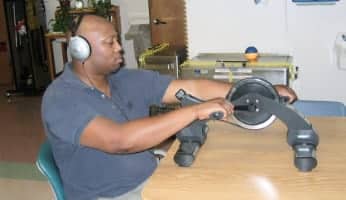Thea’s Dance Dream: IM’s Role in Coordination and Academic Improvements

Home - Testimonials - Pediatric Testimonials - Thea’s Dance Dream: IM’s Role in Coordination and Academic Improvements

Thea is a 10 year old female referred for an OT evaluation by her mother and primary pediatrician following a neurology assessment.
Diagnoses for Thea include dyspraxia, attention deficit hyperactivity disorder, post traumatic brain injury, and post-traumatic stress disorder.
She was also receiving medication to address symptoms associated with hyperactivity.
Although receiving her education in the regular academic classroom, Thea is on an IEP (Individual Education Program).
Thea’s mother reported her primary concerns to be related to the child’s clumsiness in motor movements. She described her daughter as weak in muscle strength with limited endurance.
Thea was described as having poor motor planning skills.
She required repeated instructions to develop a new or unfamiliar motor plan as was observed when attempting to learn routines for dance.
Thea was very rigid about routines.
Her parents described her writing as “difficult to read”.
There were also some concerns with self-care skills including difficulty straightening her clothing or having poor awareness of food on her face before leaving the house.
Additionally, she had difficulty completing her shower routine while incorporating good hygiene practices.
Initial Evaluation
Initial OT evaluation consisted of administration of the Bruininks-Oseretsky Test of Motor Proficiency 2nd Edition. The BOT-2 is a standardized test given to children from 4 to 21 years of age to assess 4 different areas of motor function: fine manual control, manual coordination, body coordination, and strength and agility.
Fine motor control assesses motor skills involved in drawing, which require a relatively high degree of precision.
Manual coordination assesses motor skills involved in reaching, grasping and manipulating objects with an emphasis on speed, dexterity, and coordination of arms and hands. (Gross motor testing was completed by Thea’s physical therapist and included in this documentation for thoroughness of summary.)
Thea received the following scores on the BOT-2 when scored using the female specific norms:| Subtest | Standard Score | Percentile Rank | Category |
|---|---|---|---|
| Fine Motor Control | 45 | 31% | Average |
| Manual Coordination | 18 | 33% | Below Average |
| Body Coordination | 35 | 7% | Below Average |
| Strength and Agility | 37 | 10% | Below Average |
Thea was cooperative throughout all aspects of testing; therefore, results of testing should be considered a good representation of her developmental skills.
Thea presented with a generally low tone appearance. This was further supported with observation of her hands which appeared to lack formation of palmar arches as would be concurrent with this age and stage of child development.
She had difficulty regulating the amount of force needed when throwing a ball, oftentimes undershooting or overshooting in her efforts. Thea held a pencil using a tight, three-point grasp with her thumb wrapped over the top of her first finger. She was able to form prewriting strokes and shapes that had rounded, rather than pointed corners.
Overall based on results of testing, Thea was not performing functionally at a level equal to her performance on testing.
Thea was assessed using The Print Tool; The purpose of this print from dictation test is to control for aspects of processing which can be found in situations where errors in legibility are associated with challenges in formation of thought.
The results of Thea’s assessment were not consistent with her mother’s reports of her functional handwriting, which means the errors were probably related to overall processing ability.
Thea received OT intervention over a course of 9 months. During that time, OT intervention consisted of graded therapeutic strategies working on increasing core strength, body awareness, motor planning, manual coordination, and fine motor control to address the areas of concern indicated by her mother and the results of testing.
OT intervention also included OT home programming strategies which Thea implemented with excellent carryover.
Thea’s OT intervention included the Interactive Metronome® (IM), which was initiated through the administration of a Long Form Assessment (LFA) pre-test. Interactive Metronome® is the only training program that improves timing in the brain in an organized, systematic, flexible and engaging format.
Research shows that engaging whole body movements in combination with cognitive tasks leads to overall better outcomes. IM is a patented and unique training tool that challenges thinking and movement simultaneously, providing realtime millisecond feedback to help synchronize the body’s “internal clock.”
As noted in the pre-test summary, several of the LFA tasks were unable to be completed to obtain a score due to Thea’s lack of strength to activate the trigger.
Due to Thea’s emotional sensitivity, she was extremely reluctant about participating in IM tasks which were new to her. With encouragement from her mother and trust in her therapist which was established by the previous rapport they had built, Thea reluctantly participated in the motor planning tasks suggested by her therapist.
Thea demonstrated limited endurance with most tasks as noted by frequently asking “How long is this going to be?” or “How many more do I have to do?” She frequently asked to sit down for tasks and was reluctant to stand for the duration of the activity when prompted to do so.
Due to such limited endurance, the Attend Over Time task was not taken at the time of the initial IM assessment.
Initial Long Form Assessment calculations are as follows:| Task | MS | Early Hits | Late Hits |
|---|---|---|---|
| Left Hand | 240 | 26 | 4 |
| Left Hand/Right Toe | 97 | 11 | 10 |
| Both Hands (w/Guide Sounds) | 239 | 51 | 2 |
* All other tasks attempted, but no scores reported.
Training with IM
Thea began her IM training at a frequency of 1x/wk during her regularly scheduled 45-min treatment sessions. The purpose of this refinement of intervention was to increase Thea’s comfort level with IM activities and to establish a new routine for intervention.
After four months of intervention at 1x/week, Thea’s frequency was increased to 3x/week and 1 hour treatment sessions. IM tasks at 1x/ wk consisted initially of unilateral activity to increase timing and basic motor planning skills.
The tempo for Thea was slowed to 44 beats/min in effort to establish better awareness and approximation of motor movements to the tempo.
Gradually, tempo was increased to protocol 54 beats/min. Visual guides were initially used to provide cues as to timing/tempo with auditory cues providing overstimulation for Thea as noted by complaints of “This is too confusing” and “Do I have to wear the headphones?”
Visual guides were eventually combined with auditory guide and later transitioned to auditory guides only. At baseline, the burst threshold for Thea was reduced to 2 in a row to provide positive reinforcement and a sense of mastery during IM tasks.
With continuation of intervention, the burst threshold was gradually increased to 4 in a row.
Overall, timing and motor coordination improvements were seen as noted by declining millisecond timing averages as treatment progressed.
Functionally, Thea’s general endurance, cooperation, and overall self-esteem increased as noted by willingness to challenge herself to longer tasks, positive self-talk regarding her IM performance, and eagerness to get started with the day’s treatment plan.
Thea became increasingly independent in discussing activities to implement into treatment routine and actively sought to increase the number of repetitions for greater practice.
At baseline, Thea was having difficulty completing tasks of 100 repetitions but was able to increase this performance to completing tasks of 1000 repetitions by the end of the 15-session regimen.
Thea even requested strategies to practice the IM motor planning activities in the home and reported carryover of the therapist’s suggestions.
Thea’s parents shared the observation of this increase in selfsatisfaction and reported to the therapist Thea’s comment, “This therapy seems to be working!”
Near the end of 15-sessions of IM training, Thea tried out for a more advanced dance team and was able to secure a spot following try outs.
Her parents said that Thea seemed to learn the dance routines with much less repetition than previously seen.
Also, they noticed increased independence with self-care skills, better legibility of handwriting, and there were observable improvements in homework assignments.
After 15 sessions of IM, Thea was able to complete all aspects of long-form testing with millisecond timing within the average range.
She was able to complete the Attend Over Time task with timing performance within the average range.
Getting Results with IM
At discharge, the following results were obtained using the Bruininks-Otseretsky Test of Motor Proficiency| Subtest | Standard Score | Percentile Rank | Category |
|---|---|---|---|
| Fine Motor Control | 38 | 12% | Below Average |
| Manual Coordination | 53 | 62% | Below Average |
| Body Coordination | 36 | 8% | Below Average |
| Strength and Agility | 43 | 24% | Average |
Qualitative improvements were seen during standardized testing including improved ability to throw/catch a ball with accuracy and modulation of force to meet the activity’s requirements.
Overall, postural strength had improved as noted by improved posture during handwriting tasks, decreased seeking of support from the environment (leaning on tables, against walls, seeking support from chairs when standing).
Generalized endurance improved, as noted by ability to participate in tasks without fatigue or requesting to be finished.
Significant Improvements after IM Training
Final Long Form Assessment calculations are as follows:| Task | MS | Early Hits | Late HIts |
|---|---|---|---|
| Both Hands | 25.38 | 35 | 18 |
| Left Hand | 60.24 | 14 | 15 |
| Both Toes | 29.83 | 13 | 17 |
| Left Toe | 62.86 | 17 | 12 |
| Both Heels | 62.52 | 19 | 10 |
| Right Heel | 138.76 | 19 | 10 |
| Left Heel | 132.68 | 18 | 10 |
| Left Hand/Right Toe | 38.54 | 13 | 11 |
| Balance Right Foot/Tap Left Toe | 60.10 | 19 | 10 |
| Balance Left Foot/Tap Right Toe | 131.97 | 16 | 14 |
| Both Hands (w/ Guide Sounds) | 21.75 | 32 | 20 |
Thea was discharged after the completion of 15 sessions of clinic based OT intervention including IM activities with initial goals met.
At time of discharge, LFA pos-testing was completed, which consisted of information documented above.
Thea demonstrated greater postural support and generalized strength as noted by ability to complete significantly more of the LFA tasks than seen at time of initial evaluation.
Thea participated in all of the recommended tasks without complaints of fatigue.
Significant improvements were seen in Thea’s overall timing and motor planning performance as indicated by timing results.
Possibly the most beneficial for Thea, was the confidence that she radiated as she participated in IM tasks.






